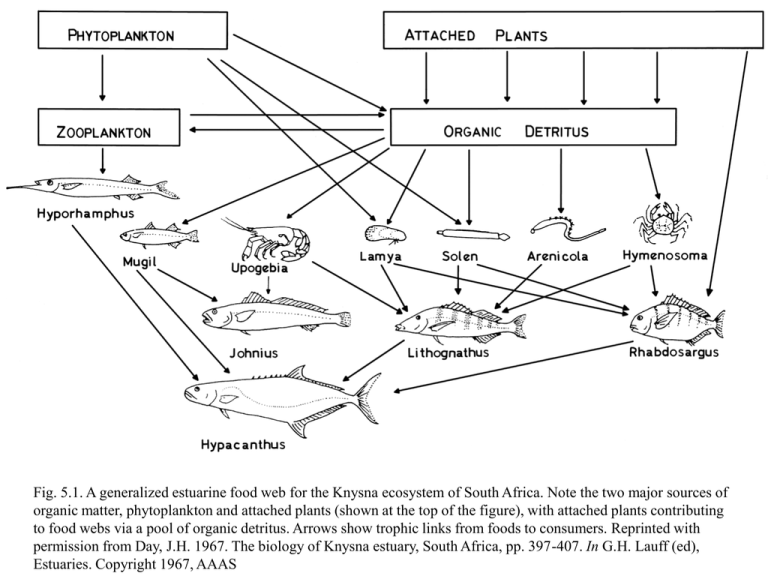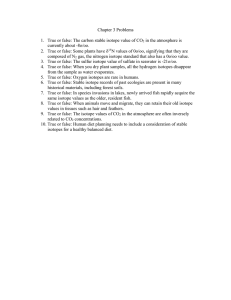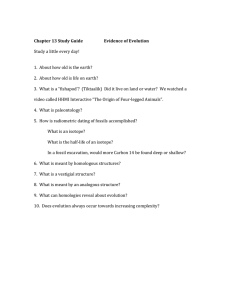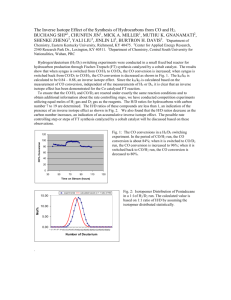Chapter 5 figures.ppt
advertisement

Fig. 5.1. A generalized estuarine food web for the Knysna ecosystem of South Africa. Note the two major sources of organic matter, phytoplankton and attached plants (shown at the top of the figure), with attached plants contributing to food webs via a pool of organic detritus. Arrows show trophic links from foods to consumers. Reprinted with permission from Day, J.H. 1967. The biology of Knysna estuary, South Africa, pp. 397-407. In G.H. Lauff (ed), Estuaries. Copyright 1967, AAAS Fig. 5.2. A 2-source estuarine food web as a coloring (dye) experiment. Isotope labeling could trace the flow of color (tracer) through the major branches of the food web. As diagrammed, fisheries production is more linked to (yellow) detritus from attached plants. Diagram reprinted with permission from Day, J.H. 1967. The biology of Knysna estuary, South Africa, pp. 397-407. In G.H. Lauff (ed), Estuaries. Copyright 1967, AAAS. Fig. 5.3. Carbon isotopes in the food web of a Texas seagrass meadow (Parker 1964). Animals are a mixture of algal and seagrass carbon. Adapted from Geochimica et Cosmochimica Acta, v. 28. P.L. Parker. The biogeochemistry of the stable isotopes of carbon in a marine bay, pp. 1155-1164. Copyright 1964, with permission from Elsevier. Fig. 5.4. Conceptual model of carbon flow in the Texas seagrass meadows, with only two carbon sources present, seagrass and phytoplankton (P.L. Parker, personal communication, ca. 1976). Fig. 5.5. Carbon isotope values for organic matter in sediments from bays and lagoons of the south Texas coast, near the border with Mexico. Highest d13C values occur in the seagrass meadows of the Upper Laguna Madre, consistent with high inputs of 13C-enriched seagrasses (d13C = -10o/oo). In other deeper bay sites that lack seagrass, d13C values are consistent with strong inputs from phytoplankton, not seagrass. X = sample collected in shallow water inside seagrass meadows, dot = sample collected in deeper bays or in the deeper Intracoastal Waterway that traverses the seagrass meadows in the Upper Laguna Madre. Reprinted from Geochimica et Cosmochimica Acta, vol. 41, B. Fry, R.S. Scalan and P.L. Parker. Stable carbon isotope evidence for two sources of organic matter in coastal sediments: Seagrasses and plankton, pp. 1875-1877. Copyright 1977, with permission from Elsevier. Fig. 5.6. Histogram of carbon isotopes in plants and consumers from seagrass meadows of the Upper Laguna Madre (dark) and from the offshore Gulf of Mexico (white). Phytoplankton inputs dominate in the offshore ecosystem, while values are shifted away from the phytoplankton values towards seagrass values in the Upper Laguna Madre (from Fry and Parker 1979). Fig. 5.7. Histogram of carbon isotopes in marine macroalgae (Fry and Sherr 1984; used with permission from Contributions in Marine Science). Fig. 5.8. Conceptual mixing models for carbon isotopes. Our seagrass research started with the a two-source model (Model A) with -20o/oo phytoplankton and -10o/oo seagrasses contributing 50/50 to -15o/oo consumers (open circles; closed circles are sources). But further work changed the picture. Especially discovery that marine macroalgae had intermediate -15o/oo isotope values. This complicated interpretation of the isotope results (model B), creating a “mixing muddle” with no unique solution, i.e., source contributions of 50/0/50 and 0/100/0 were both logically possible. To resolve this muddle, we turned to observational studies, comparative isotope surveys, and more tracers, as explained in the text. (Adapted from Fry and Sherr 1984; used with permission from Contributions in Marine Science). Fig. 5.9. Carbon isotopes in plants and animals from six Texas seagrass meadows. Dashed line connects values of epiphytes while solid line connects seagrass values. Letters denote common consumers. Note that consumer values usually fall close to those of epiphytes or are intermediate between those of seagrasses and epiphytes, consistent with strong epiphyte inputs to the local food webs (From: Kitting, C.L., B. Fry, and M.L. Morgan. 1984. Detection of inconspicuous epiphytic algae supporting food webs in seagrass meadows. Oecologia (Berlin) 62:145-149. This is reprint of Figure 4, p. 148 from the article and is used with permission from Springer). Fig. 5.10. Dual-isotope, carbon-sulfur isotope diagram for the food web in seagrass meadows at Redfish Bay, Texas, sampled in 1980 (Fry, 1981). Rectangles indicate ranges of measured plant values in the case of seagrasses, macroalgae and epiphytes; offshore plankton values are estimates (Fry et al. 1987). The diamond symbols indicate isotope values for common consumers, including 4 shrimp species, blue crabs, snails, toadfish, pipefish and anchovies. Fig. 5.11. Mixing models for percentages, nitrogen and carbon isotopes – blue and yellow sources at the ends of the scales yield a green sample in the middle; colors and isotopes index the % contributions of the sources, 50% - 50% in these cases. Fig. 5.12. As Fig. 5.11, but for sulfur, oxygen and hydrogen stable isotopes. Fig. 5.13. Mixing models – two sources at the ends and a sample in the middle; sources contribute unequally to the sample in the top and bottom case, so the split is not 1:1, but 2:8 (top, blue source is larger contributor) and 1:9 (bottom, yellow source dominates). In these two-source mixing problems, source 1 contributes fraction f 1 and source 2 contributes fraction f2 to the mixed intermediate sample so that f1 + f2 = 1, f2 = 1- f1 and as derived in section 5.3, f1 = (dSAMPLE – dSOURCE2)/(dSOURCE1-dSOURCE2). Fig. 5.14. Mixing red and blue chocolate candy in different proportions – the color gives the mix proportions, without actually having to count all the candy. Paired numbers are # of red chocolates /# of blue chocolates. Chocolate proportions in bottom panel were calculated assuming a starting 50/50 mix (middle panel) then removing red chocolates twice as fast as blue chocolates. (Precise calculations for these removals followed the closed system fractionation rules explained later in this book, in section 7.2). Fig. 5.15. Isotope mixing between two sources is governed by a combination of two things: isotope compositions of the sources, and also amounts (mass) of sources. So, when mixing only two sources, there are actually four things to keep track of, i.e., source A isotopes, source A amounts, source B isotopes and finally source B amounts. This figure shows that when one or more of these four quantities is not fixed, but can vary, mixing of even two sources can get complex. From: Krouse (1980). Used with the author’s permission. Guide to the 9 examples distinguished by the numbered circles: 1. Only source A is present, and source A has fixed isotope value and mass. 2. Source A has a constant isotope value, but can vary in mass. 3. Source A can vary in isotope value, but has a constant mass. 4. Sources A and B have fixed isotope values, source A has a fixed low mass, but source B increases in mass. Mixing results will approach the isotope value of source B as the mass of source B increases. 5. Source A can vary in isotope value, but has a constant low mass. Source B has a constant isotope value, but can increase in mass. The resulting family of mixing curves all approach the isotope value of source B as the mass of B increases. 6. Source A can vary in isotope value and has a variable, but low mass. Source B has a fixed isotope value, and can increase in mass. As mass increases, results approach the isotope value of source B. 7. Sources A and B have fixed isotope values, and can each vary in narrow, but fairly similar mass ranges. The shaded envelope gives the range of possible mixing outcomes. AMOUNT (MASS) 8. Source A is not really depicted, but has a near-zero mass and widely variable isotope values. Source A is perhaps better thought of not as a single source, but as a family of sources. Source B has a fixed isotope value and can increase in mass. At higher mass, isotope values converge on the dominant source, source B. 9. Source A is fixed in isotope value and has a low mass, and mixes with various other “B” sources that all have higher mass, but different isotope values. The shaded envelope gives possible mixing solutions. Fig. 5.16. Propagated errors (uncertainty) for a sample that is a 50/50 mix of two sources, when sources differ by 5 or 10o/oo (red difference = 5o/oo, blue difference = 10o/oo). At an equal level of error in the replicates (i.e., at any fixed value along the x-axis) uncertainty is higher when the sources are closer in isotope values. For example, when the difference between sources is 10o/oo (bottom blue line), to achieve a level of 10% uncertainty (y value), the replication errors (x value) must be about 0.66o/oo. When the difference between sources is 5o/oo (top red line), replication errors must shrink to 0.33o/oo to achieve the same 10% level of uncertainty. Fig. 5.17. Mixing models and muddles. Bottom graph shows mixing muddle where there are three sources and no unique solution for source contributions to the sample, which is shown as a filled triangle and sources are depicted as squares. To resolve the muddle, one can measure another tracer, gaining resolution if lucky (left middle) or not gaining resolution if unlucky (right middle). A surer way to gain resolution is to add isotope artificially to one source (top). All sources contribute equally to the sample in these examples. Figure 5.18. Hypothetical water flux, sulfate concentrations, and sulfate isotopes along a stretch of the Mississippi River. Fig. 5.19. Nitrogen concentrations and isotopes in an hypothetical lake core (top panels), and interpretation of the source contributions from mixing model equations (bottom panels). Fig. 5.20. Hypothetical mixing results for two sources across an estuarine landscape composed of open water (ow) and marsh, with the ow:marsh ratio varying from pure marsh (ratio = 0) towards higher values characteristic of mostly open water. The two sources creating the mixing dynamic are phytoplankton in open water and Spartina plant carbon exported from marshes. The y-axis scales the relative contributions of the two sources. The numerical y-values show an index that varies from 0 to 100, and could be % contribution of Spartina, or also the o/oo value of samples in the hypothetical case that Spartina has a d value of 100o/oo and phytoplankton a value of 0o/oo. Both phytoplankton and Spartina sources contribute to DOC (dissolved organic carbon) and POC (particulate organic carbon) pools. Top graph: phytoplankton and Spartina have equal quality for DOC and POC pools. Bottom graph: In food webs, Spartina is much less important because it has a 10x lower quality than phytoplankton. Fig. 5.21. As previous figure, but for nitrogen stocks, not carbon. DON = dissolved organic nitrogen, PON = particulate organic nitrogen. See Fig. 5.19 for explanation of the x and y axes. Top: maximum contribution scenario for Spartina exported from marshes, assuming high inputs of labile DON from marshes and low N inputs from other sources. Bottom: more likely scenario that shows marsh inputs are quite minor for food webs in most current estuaries that have high anthropogenic N loading, with high inputs of labile DON from marshes, but inputs from other sources that are 50x higher than marsh inputs. The inset panel shows an expanded view of the results for Open Water:Marsh ratios of 1 or less. Fig. 5.22. Hypothetical growth and isotope changes for a tuna that is switching diets. Muscle, liver and blood plasma are three tissues that turn over at respectively slow, medium and fast rates as the tuna grows. The new diet has a different isotope label than the starting diet, and differential turnover in the three tissues leads to different isotope changes with time. Isotope changes can be used to construct a clock that times progression of the turnover (bottom). From Answers to Problems, Problem 10 in Chapter 5. Fig. A. Preliminary isotope biplot, a common starting point in the graphic analysis of stable isotope data. From Answers to Problems, Problem 10 in Chapter 5. Fig. B. As previous figure, but with carbon data on the x-axis, as per modern convention. From Answers to Problems, Problem 10 in Chapter 5. Fig. C. As previous figure, but with d symbols now correctly given, including superscripts. From Answers to Problems, Problem 10 in Chapter 5. Fig. D. As previous figure, but the o/oo units on the x and y axes are now similar (i.e., spacing for a 1 o/oo interval on the x-axis equals the spacing for 1 o/oo on the y-axis). From Answers to Problems, Problem 10 in Chapter 5. Fig. E. As previous figure, but with added data from the second round of sampling. From Answers to Problems, Problem 10 in Chapter 5. Fig. F. As previous figure, but with axes relabeled to show interpretation of d13C results in terms of sources (x-axis) and interpretation of d15N results in terms of trophic level (yaxis). From Answers to Problems, Problem 10 in Chapter 5. Fig. G. Minimum and maximum (“minmax”) contributions for a five-source mixing problem in which there are too many sources and not enough tracers. There is no unique average solution in these common cases, only min-max range estimates for each source. From Answers to Problems, Problem 10 in Chapter 5. Fig. H. As previous figure, but only maximum contributions. From Answers to Problems, Problem 10 in Chapter 5. Fig. I. As previous figure, but only minimum contributions.





